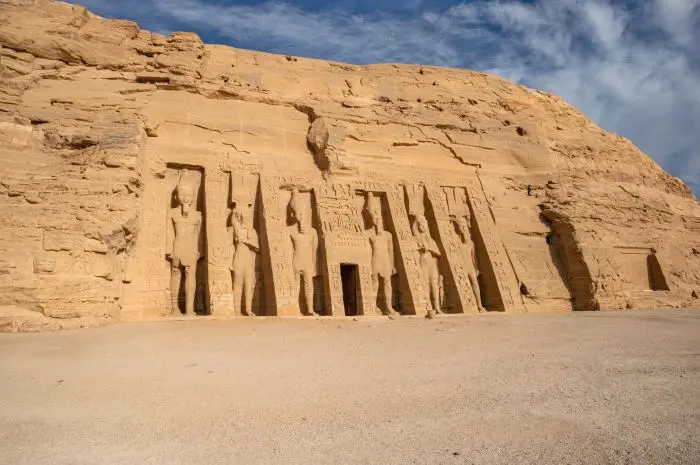Nestled on the banks of the Nile River in southern Egypt, the remarkable temple complex of Abu Simbel stands as a testament to the grandeur and genius of ancient Egyptian civilization.
Carved into the cliffs, this UNESCO World Heritage Site attracts visitors from around the globe who are captivated by its rich history, awe-inspiring architecture, and cultural significance.
In this article, we embark on a virtual journey to Abu Simbel, delving into its intriguing past, exploring its significance, and providing practical information for those planning a visit.
History
The history of Abu Simbel dates back to the reign of Pharaoh Ramses II in the 13th century BCE, during the New Kingdom period of ancient Egypt.
Commissioned as a grandiose temple complex dedicated to Ramses II himself and the gods Amun, Ra-Horakhty, and Ptah, the site was strategically chosen to showcase the pharaoh’s power and divine status.
The temples were meticulously carved into the sandstone cliffs to protect them from the ravages of time, ensuring their survival for centuries to come.
Why Visit
Abu Simbel offers an extraordinary opportunity to witness the magnificence of ancient Egyptian architecture and immerse oneself in the rich tapestry of history.
The temples are not only remarkable for their sheer size but also for the intricate details and exquisite craftsmanship that went into their creation.
The colossal statues, intricate wall reliefs, and hieroglyphic inscriptions transport visitors to a bygone era, providing a glimpse into the religious, cultural, and political life of ancient Egypt.
Location and Route
Abu Simbel is located approximately 280 kilometers (175 miles) south of Aswan, Egypt. While it may seem remote, reaching this ancient wonder is made possible through various transportation options.
The most popular method is by air, with daily flights operating from Aswan and Cairo to Abu Simbel Airport.
Alternatively, travelers can embark on a picturesque journey by Nile cruise, enjoying the scenic beauty of the river along the way.
Road travel is also an option, with organized tours and private cars available for those seeking a more flexible itinerary.
When to Visit
Egypt’s climate can be harsh, and the scorching temperatures of the summer months make visiting Abu Simbel uncomfortable for many travelers.
The best time to visit is during the milder months from October to April when the weather is more temperate, allowing for a more enjoyable and comfortable experience.
Additionally, it is worth noting that twice a year, on February 22 and October 22, an extraordinary phenomenon occurs.
The rising sun aligns perfectly with the temple’s entrance, illuminating the inner sanctuary and casting light upon the statues of Ramses II and the gods seated inside—a truly magical sight that attracts crowds of visitors.
What to See
Upon arrival at Abu Simbel, visitors are greeted by the colossal statues of Ramses II, each standing at a staggering 20 meters (65 feet) in height.
These statues guard the entrance to the Great Temple, which is the larger of the two structures.
Stepping inside, one is immediately struck by the grandeur of the hall, supported by eight colossal statues of Ramses II himself.
The walls are adorned with intricate reliefs depicting scenes of military victories, religious rituals, and the pharaoh’s divine lineage.
Adjacent to the Great Temple is the smaller but equally impressive Temple of Hathor, dedicated to Ramses II’s wife, Queen Nefertari, and the goddess Hathor. The exterior of this temple features six statues—four of Ramses II and two of the queen.
The interior is no less awe-inspiring, with vibrant colors and detailed reliefs showcasing the significance of the queen and the goddess Hathor in ancient Egyptian mythology and religious practices.
In addition to the temples, visitors can explore the nearby Nubian Museum, which provides insights into the history and culture of the region, shedding light on the significance of Abu Simbel within the larger context of ancient Nubian civilization.
Conclusion
Abu Simbel is a destination that transcends time, offering a profound connection to ancient Egypt’s glorious past.
Its historical significance, architectural marvels, and cultural richness make it a must-visit for history enthusiasts, art lovers, and anyone seeking to be enchanted by the wonders of our shared human heritage.
So, embark on a journey to Abu Simbel, immerse yourself in its splendor, and unlock the secrets of an ancient civilization that continues to captivate and inspire us to this day.
